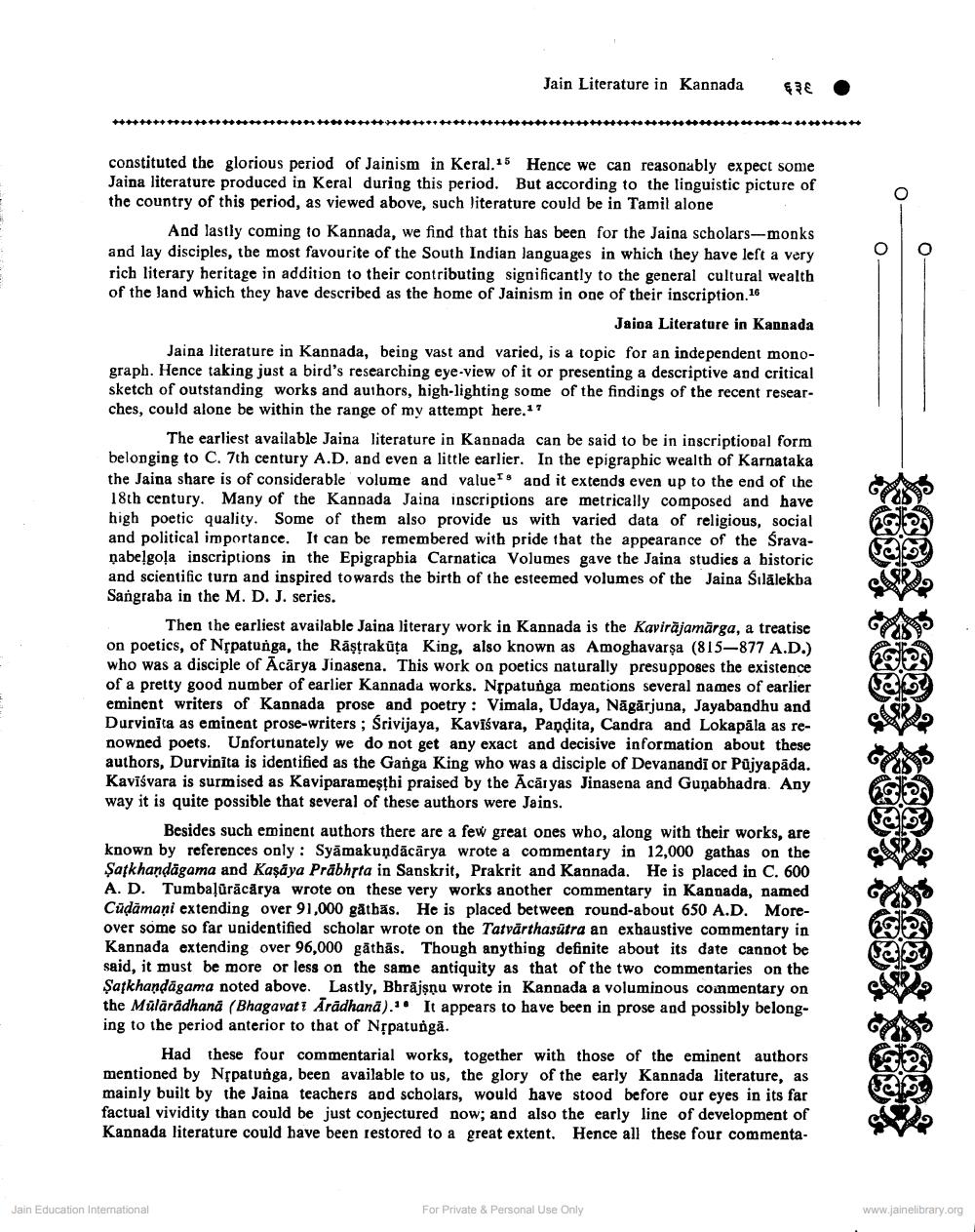Book Title: Jain Literature in Kannada Author(s): B K Khadabadi Publisher: Z_Pushkarmuni_Abhinandan_Granth_012012.pdf View full book textPage 3
________________ Jain Literature in Kannada RE oo constituted the glorious period of Jainism in Keral.15 Hence we can reasonably expect some Jaina literature produced in Keral during this period. But according to the linguistic picture of the country of this period, as viewed above, such literature could be in Tamil alone And lastly coming to Kannada, we find that this has been for the Jaina scholars-monks and lay disciples, the most favourite of the South Indian languages in which they have left a very rich literary heritage in addition to their contributing significantly to the general cultural wealth of the land which they have described as the home of Jainism in one of their inscription.16 Jaioa Literature in Kannada Jaina literature in Kannada, being vast and varied, is a topic for an independent monograph. Hence taking just a bird's researching eye-view of it or presenting a descriptive and critical sketch of outstanding works and authors, high-lighting some of the findings of the recent researches, could alone be within the range of my attempt here.17 The earliest available Jaina literature in Kannada can be said to be in inscriptional form belonging to C. 7th century A.D, and even a little earlier. In the epigraphic wealth of Karnataka the Jaina share is of considerable volume and values and it extends even up to the end of the 18th century. Many of the Kannada Jaina inscriptions are metrically composed and have high poetic quality. Some of them also provide us with varied data of religious, social and political importance. It can be remembered with pride that the appearance of the Sravaņabelgoļa inscriptions in the Epigraphia Carnatica Volumes gave the Jaina studies a historic and scientific turn and inspired towards the birth of the esteemed volumes of the Jaina Silälekba Sangraba in the M. D. J. series. Then the earliest available Jaina literary work in Kannada is the Kavirajamärga, a treatise on poetics, of Nrpatunga, the Răstrakūta King, also known as Amoghavarşa (815-877 A.D.) who was a disciple of Ācārya Jinasena. This work on poetics naturally presupposes the existence of a pretty good number of earlier Kannada works. Nppatunga mentions several names of earlier eminent writers of Kannada prose and poetry : Vimala, Udaya, Nāgārjuna, Jayabandhu and Durvioita as eminent prose-writers; Srivijaya, Kavīśvara, Pandita, Candra and Lokapāla as renowned poets. Unfortunately we do not get any exact and decisive information about these authors, Durvinīta is identified as the Ganga King who was a disciple of Devanandi or Pujyapada. Kaviśvara is surmised as Kaviparameșthi praised by the Ācāryas Jinasena and Gunabhadra. Any way it is quite possible that several of these authors were Jains. Besides such eminent authors there are a few great ones who, along with their works, are known by references only: Syāmakundācārya wrote a commentary in 12,000 gathas on the Şarkhandagama and Kaşaya Prabhrta in Sanskrit, Prakrit and Kannada. He is placed in C. 600 A. D. Tumbaļūrācārya wrote on these very works another commentary in Kannada, named Cūdamani extending over 91,000 gåthas. He is placed between round-about 650 A.D. Moreover some so far unidentified scholar wrote on the Tatvärthasūtra an exhaustive commentary in Kannada extending over 96,000 gathās. Though anything definite about its date cannot be said, it must be more or less on the same antiquity as that of the two commentaries on the Şafkhandāgama noted above. Lastly, Bbrājsnu wrote in Kannada a voluminous commentary on the Mülāradhana (Bhagavati Aradhana).1. It appears to have been in prose and possibly belonging to the period anterior to that of NȚpatunga. Had these four commentarial works, together with those of the eminent authors mentioned by Nịpatunga, been available to us, the glory of the early Kannada literature, as mainly built by the Jaina teachers and scholars, would have stood before our eyes in its far factual vividity than could be just conjectured now; and also the early line of development of Kannada literature could have been restored to a great extent. Hence all these four commenta Jain Education International For Private & Personal Use Only www.jainelibrary.orgPage Navigation
1 2 3 4 5 6
